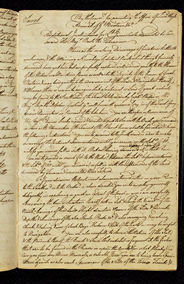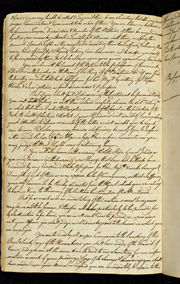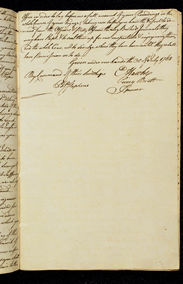

Secret Instructions to Lieutenant Cook 30 July 1768 (GB)
Significance
The Secret Instructions, contained in the Letterbook carried on the Endeavour, include the Additional Instructions which authorised James Cook to take possession of 'a Continent or Land of great extent' thought to exist in southern latitudes. The second page instructs Cook 'with the Consent of the Natives to take possession of Convenient Situations in the Country in the Name of the King of Great Britain'.
History
James Cook made three voyages to the South Pacific between 1768 and 1779 and on each occasion carried 'Secret Instructions' from the British Admiralty. These contained an outline of the route of the voyage, described the activities he and his men were to undertake, and the manner in which he was to report his progress. They were secret in that they held the real intentions and plans for the voyage, while other papers issued would be made available on demand to show Cook's authority for his command and the enterprise.On his first voyage, Cook sailed in the Endeavour to Tahiti (to assist in the scientific observation of the transit of the planet Venus) and then as instructed, sailed south in search of the fabled 'Great Southern Continent'.
The Secret Instructions provided that, in the event that he found the Continent, he should chart its coasts, obtain information about its people, cultivate their friendship and alliance, and annex any convenient trading posts in the King's name. Cook followed the coast of New Zealand (thereby debunking Abel Tasman's theory that it formed part of the southern continent), then turned west, reaching the southern coast of New South Wales on 20 April 1770. He sailed north, landing at Botany Bay one week later, before continuing to chart the Australian coast all the way north to the tip of Queensland. There, on Possession Island, just before sunset on Wednesday 22 August 1770, he declared the coast a British possession:
Notwithstand[ing] I had in the Name of His Majesty taken possession of several places upon this coast, I now once more hoisted English Coulers and in the Name of His Majesty King George the Third took possession of the whole Eastern Coast . . . by the name New South Wales, together with all the Bays, Harbours Rivers and Islands situate upon the said coast, after which we fired three Volleys of small Arms which were Answerd by the like number from the Ship.Cook had recorded signs that the coast was inhabited during the voyage north, and here he noted as he returned to the ship the great number of fires on all the land and islands about them, 'a certain sign they are Inhabited'.
Cook then sailed through Torres Strait, returning to England in May 1771.
Cook's Secret Instructions represent Britain’s first official expressions of interest in Australia. They record the quest for scientific discovery, combined with the desire to find exploitable natural resources and to expand Britain's control of strategic trading posts around the globe. The Instructions confidently assume that these varied interests could be made compatible with a respect for the native populations in those countries so identified.
Cook's report of his observations along the New South Wales coastline on his first voyage formed the basis for Britain's decision to establish the colony at Botany Bay in 1788. His careful charting of the coast also formed the basis for the British Admiralty Charts of Australian waters produced by the Hydrographic Office of the Admiralty from its establishment 20 years after Cook's voyage along the eastern coast of Australia.
Cook's second and third voyages involved a fuller exploration of the Pacific and Atlantic, including the search for a north-west passage through the Pacific to the Atlantic. He was instructed to make scientific observations and collect natural specimens, and to show 'every kind of civility and regard' to the natives, at the same time taking care not ‘to be surprized by them’. With their consent, he was to take possession in the name of the King of any convenient situations in any country he might discover. Cook eventually reached the north-west passage (the Bering Strait), but it was ice-bound and he was unable to cross it. Returning through the South Pacific, he was killed in the Sandwich Islands (Hawaii) on 14 February 1779.
Description
The full Secret Instructions are contained in six pages of the Letterbook. The pages are yellowed paper, the ink faded to brown. The Letterbook has a stiff cover with a marbled pattern and is housed in a case covered in paper of a similar marbled pattern. | Long Title: | Secret Instructions for Lieutenant James Cook Appointed to Command His Majesty's Bark the Endeavour 30 July 1768 |
| No. of pages: | 6 (3 shown here) |
| Medium: | Paper with a heavier patterned cover |
| Measurements: | 17 inches x 13.5 inches |
| Provenance: | Acquired by National Library |
| Features: | This Letterbook, still in its original marbled paper cover, was carried aboard the Endeavour and contains the only surviving set of Cook's original Secret Instructions |
| Location & Copyright: | National Library of Australia |
| Reference: | NLA: MS 2 |


